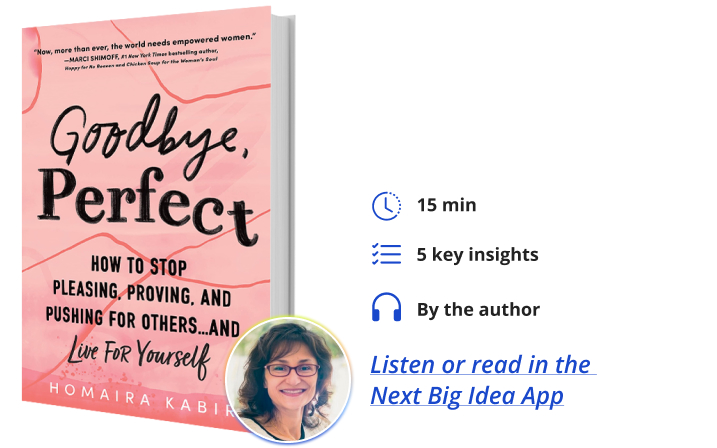Homaira Kabir is the founder and CEO of Goodbye Perfect Project. She is also a confidence coach. She holds Master’s degrees in Coaching Psychology and in Positive Psychology from the University of East London and has completed postgraduate research on women’s confidence. She is the founder of Her Becoming, an enterprise dedicated to women’s empowerment and her work is widely published in Forbes, Happify, ThriveGlobal, the Huffington Post, Positive Psychology News Daily, and more.
Below, Homaira shares 5 key insights from her new book, Goodbye, Perfect: How to Stop Pleasing, Proving, and Pushing for Others… and Live For Yourself. Listen to the audio version—read by Homaira herself—in the Next Big Idea App.

1. Functioning is not the same as flourishing.
Functioning is about showing up. It’s about raising kids, performing duties, getting through the day-to-day with a certain level of resilience, and most of us can do that. However, flourishing is different. It’s about getting out of bed with a spring to your feet because you’re drawn by a deeper relationship with life. Flourishing is about joy, ease, and purpose, and about growing into the best version of yourself.
Not a lot of us are flourishing. Some of us can feel the angst of it, while others are so involved in their day-to-day functioning that they don’t even have time to think about it. When I recovered from my eating disorder after a nearly 10-year struggle, I didn’t find myself flourishing. My life was good on the outside, but every so often, I would get this gnawing feeling that something was missing. I would think back to my eating disorder days and wonder whether I’d fought the biggest battle of my life for this. I knew that there was something more I was here to do.
Many of my coaching clients spoke about the same disconnect with their lives. Like me, they were waiting for their real lives to begin, and hoping I’d be able to guide them toward it. These were competent, conscientious, and ambitious women: the star performers, the super moms, the ones who got everything done and were there for everyone. They weren’t just functioning; they were high functioning, but by and large, they were also stressed, overwhelmed, and burnt out. They were always pushing themselves to meet often unreasonable expectations, and they were their own hardest critics when they couldn’t do so. I related to their experience. There was the feeling of always trying harder and still not getting far; like pushing a boulder up a mountain. All I had as solutions were more self-care, more boundary setting, more discernment, and less perfection and control.
The problem was that they already knew this. They were well aware of the patterns that were keeping them stuck or unhappy, and what to do about it. However, taking action was terribly hard despite the knowledge, because the moment of truth was rife with intense emotions. It was easier to justify not taking action. Even when they did take action, guilt or self-doubt quickly followed. So I went back to school to do a Master’s in Positive Psychology—the science of flourishing. If traditional psychology helps us move from languishing to functioning, as it helped me recover from the eating disorder, Positive Psychology promises a path from functioning to flourishing. Flourishing helps us reach the highest levels of our potential.
2. We’re wired to flourish.
Every living organism, from the seed to the caterpillar, is wired to flourish. It’s called entelechy, a concept first introduced by Aristotle to describe the potential of an acorn to actualize into an oak tree. Similarly, we each enter the world with something beautiful that will grow into the best version of itself if—and this is key—it receives the right conditions to do so. For the seed, the right conditions are good soil and sunlight. For the caterpillar, the right condition is the chrysalis. For human beings, who are the most social species to exist, it is the strength of our relationships. The most important of these relationships is the one we have with our primary caregivers in the very early years of life. This is when we form the mental frameworks that become our way of perceiving and thus experiencing the world.
“For human beings, who are the most social species to exist, it is the strength of our relationships.”
Secure attachment happens when caregivers are present, attuned, and non-judgmental. They are also aware and encouraging of an authentic way of being in the world. This provides the most solid ground for flourishing; it instills in us a healthy sense of self-worth. This allows us to pursue heartfelt goals with joy and grit, and a certain grace when things don’t go our way, because our worth isn’t on the line.
Paul Gilbert, who won the order of the British Empire for his work on compassion, calls this “secure striving.” It is when our pursuits are underpinned by a sense of inner security. Contrast this with “insecure striving,” where we experience anxiety, social comparison, shame, and bouts of unhappiness in the pursuit of “should” goals that are based on what others, or what society values and rewards. The pandemics of anxiety, loneliness, depression, and purposelessness are a sign that insecure striving is an all too common reality.
3. Most of us don’t get the right conditions to flourish.
Research on attachment styles shows that most of us do not grow up with secure attachment. This is largely because it’s a tall order that nature places on caregivers, especially in a world that’s so stressful and chaotic. Despite a caregiver’s best efforts, most of us grow up in homes with some praise and some criticism. There have usually been some moments of connection and some of loneliness, or some of feeling misunderstood. This mixed bag isn’t limited to our very early years either. There are other factors that affect attachment style as well, like personality, the challenges we face, and especially the world we live in that never fails to remind us of what’s lacking in us and around us in subtle and not so subtle ways. When we don’t feel loved and seen for who we are, we try to become someone else to get the attention and appreciation we need.
My eating disorder began in Senegal in West Africa when my father was posted there as a diplomat, and I felt like a complete stranger. The focus on losing weight was a desperate attempt to matter, to be seen and appreciated for something that others valued. Of the few options, my body was the only thing I could control… until I couldn’t. Before long, the eating disorder had taken a life of its own. The patterns of behavior I engaged in during that time are no different from the patterns of perfection, pleasing, proving, and constant performing that billions of us engage in. Essentially, they are all the masks we wear to feel we’re worthy of being loved or seen by doing the things that make us so.
“When we don’t feel loved and seen for who we are, we try to become someone else to get the attention and appreciation we need.”
There are six common masks that result from insecure attachment which we can relate to in varying degrees. The beliefs underpinning the masks are often unknown to us. They live in the vast wilderness of the implicit and subconscious world because they were formed at a time when we hadn’t fully developed the cognitive capacity to make sense of things. When a situation touches upon a belief, we have no control over our emotional reaction. It is visceral and automatic, honed over millennia to keep us safe. It’s that immobilizing self-doubt you feel before something important, even when you know you have what it takes to do it well. It’s also that warm wash of shame over something so small and insignificant that you wouldn’t think twice about it if someone else did it.
Unless we address the emotion first, we’ll react to it because emotions drive action. Sometimes we react so fast, that we don’t even know we experienced an emotion; so strong is the self-protection mechanism. Understanding this is critical because it explains why we continue to do the things we know are getting in the way of our joy or growth. This explains we fall back into old patterns, especially when we face challenges. We’re protecting ourselves, and protecting and flourishing aren’t exactly bedmates.
4. We can create the conditions to flourish.
While at the University of Georgia, the late Michael Kernis developed two types of “high confidence” in scientific literature. One is called “optimal confidence,” or “optimal self-esteem,” meaning authenticity—a state which enables flourishing. The other is called “fragile self-esteem,” a state dependent on external validation such as success or approval and praise. “Fragile confidence” is a yo-yo-ing emotional journey of self-protective behaviors that keeps us stuck and shortchanges our potential. Studies on adult development by Professor Robert Kegan at Harvard University show that up to 70 percent of college-educated adults feel stuck.
However, the only real difference between “fragile confidence” and “optimal confidence” is a psychological construct called “global self-esteem,” which is a relationship of unconditional love and positive regard toward ourselves. Needless to say, this is the natural by-product of secure attachment because our relationship with ourselves is a reflection of the relationship we had with our caregivers in those early years of life.
As such, most of us have our inner work cut out for us, and our areas of struggle point us to this. These are the areas where we have to bring love and compassion, acceptance and forgiveness, encouragement and excitement as a secure attachment figure would do. I remember the time I was pregnant with my twins. Literally out of nowhere, I went into active labor at 22 weeks. I was rushed to the hospital where the doctors told us that the chances of survival of both babies was 0.6 percent. My world was pulled from beneath me and my mind fired at a million miles an hour. What did I do wrong? Why was this happening to us? The more I tried to make sense of things, the more my emotions ran the show and delivery was all but certain.’
“When we stand by our own sides in unconditional love and non-judgment, we are able to find the strength and wisdom within to do the right thing.”
However, the universe had other plans, and it pointed me to what I needed to do. During the three months that I held my babies in until they were ready to come out safely, I stood at the gates of my mind like an angel sent from heaven. By being gentle with myself, and cheering myself on multiple times a day, I refused to engage with the inner critic that had a lot to say. The doctors called me their miracle patient, but there was nothing I did more miraculous than what we’re all capable of doing. When we stand by our own sides in unconditional love and non-judgment, we are able to find the strength and wisdom within to do the right thing.
The importance of self-compassion cannot be overemphasized in this new reality where we can do everything right and still end up with a lien on the house. Our plans and aspirations can be thrown into disarray at any moment: it could be adult kids living in the basement, a war, or a pandemic.
5. All great daring begins from within.
Optimal confidence is a bottom-up approach to confidence building that begins with embracing our inherent self-worth. As writer Eudora Welty wrote, “All serious daring starts from within.”
Yet, it’s rarely the approach taken in our efforts to help people build their confidence. This general approach is based on the view that taking action builds confidence, also known as the top-down approach. We all know, or are, competent, successful, qualified people who have taken risks and done great things. However, we still continue to struggle with self-doubt and imposter syndrome despite taking action again and again.
This top-down approach is also common in leadership development because it is the overarching approach we have to life itself. In Greek philosophy, it’s described as the “patriarchal approach,” that’s based on Puritan values of right and wrong. The “matriarchal approach” is bottom-up. It begins with the truth of authenticity, interconnectedness, dreams, and aspirations, but also fears, shame, and inhibitions.
Both approaches feed off each other, but the work always begins within. Without embracing the truth of what is, a top-down approach becomes tyrannical in nature. Whether the tyranny is toward ourselves in the form of an overly vocal inner critic, or toward others, in narcissistic behaviors and by asserting power over others. It’s about fixing and rejecting, instead of using what’s already beautiful to make what’s not, better. We cannot work on our darkness if we aren’t connected to our brightness. Authenticity is the bedrock of flourishing.
There are four steps of a bottom-up approach to confidence and flourishing that begin with authenticity and end with courage. Of course, taking action does build confidence, but only if that action is aligned with who we are and what we want our lives to be about. This is important work because when we come to the end of our lives, this is all that will really matter. Was I true to myself? Did I do the work I came here to do?
We’re all born with unique gifts, and our work in the world is to nurture them, to polish them, and to give them back to the world to make it a little better than we found it. When we do so, we experience the joy and fulfillment we all seek. When we don’t, we feel the regret of having failed the world. Our individual and collective flourishing is intertwined in more ways than one, and that is nature’s wisdom at play.
To listen to the audio version read by author Homaira Kabir, download the Next Big Idea App today:































